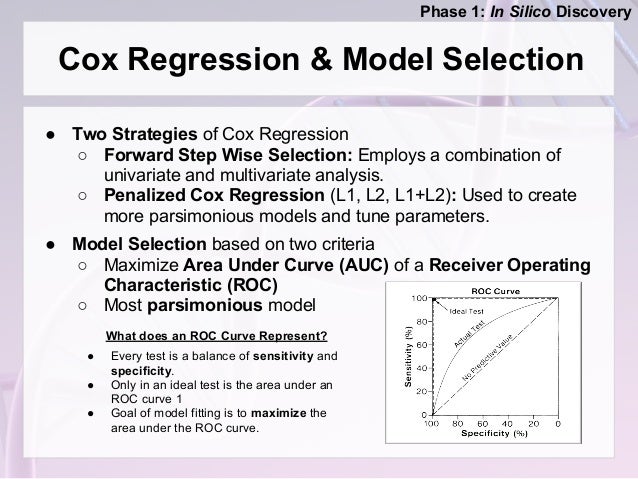
The Cox proportional-hazards model (Cox, 1972) is essentially a regression model commonly used statistical in medical research for investigating the association between the survival time of patients and one or more predictor variables. In the previous chapter , we described the basic concepts of survival analyses and methods for analyzing and summarizing survival data, including:. the definition of hazard and survival functions,. the construction of Kaplan-Meier survival curves for different patient groups.
Inoculant for lactobacillus. the logrank test for comparing two or more survival curves The above mentioned methods - Kaplan-Meier curves and logrank tests - are examples of univariate analysis. They describe the survival according to one factor under investigation, but ignore the impact of any others.
(MAC) and signet-ring cell carcinoma (SRCC) are less frequent subtypes of colorectal. Independent predictor of decreased survival in multivariate analysis. Cox stepwise regression model to select independent predictors as input for OS. Open topic with navigation. Cox (Proportional Hazards) Regression Menu location: Analysis_Survival_Cox Regression. This function fits Cox's proportional hazards model for survival-time (time-to-event) outcomes on one or more predictors. Multivariate Analysis¶ The Engine API can dynamically detect correlations between time series and model them as multivariate. For example, it may detect that DiskWrites and NetworkIO are related i.e. Changes in the values of each occur together.
Additionally, Kaplan-Meier curves and logrank tests are useful only when the predictor variable is categorical (e.g.: treatment A vs treatment B; males vs females). They don’t work easily for quantitative predictors such as gene expression, weight, or age. An alternative method is the Cox proportional hazards regression analysis, which works for both quantitative predictor variables and for categorical variables. Furthermore, the Cox regression model extends survival analysis methods to assess simultaneously the effect of several risk factors on survival time. In this article, we’ll describe the Cox regression model and provide practical examples using R software.
The need for multivariate statistical modeling In clinical investigations, there are many situations, where several known quantities (known as covariates), potentially affect patient prognosis. For instance, suppose two groups of patients are compared: those with and those without a specific genotype.
If one of the groups also contains older individuals, any difference in survival may be attributable to genotype or age or indeed both. Hence, when investigating survival in relation to any one factor, it is often desirable to adjust for the impact of others. Statistical model is a frequently used tool that allows to analyze survival with respect to several factors simultaneously. Additionally, statistical model provides the effect size for each factor. The cox proportional-hazards model is one of the most important methods used for modelling survival analysis data.
Multivariate Cox Proportional Hazard Model
The next section introduces the basics of the Cox regression model. Example data sets We’ll use the lung cancer data in the survival R package. From the output above,. The variables sex, age and ph.ecog have highly statistically significant coefficients, while the coefficient for ph.karno is not significant. age and ph.ecog have positive beta coefficients, while sex has a negative coefficient. Thus, older age and higher ph.ecog are associated with poorer survival, whereas being female (sex=2) is associated with better survival.
Now, we want to describe how the factors jointly impact on survival. To answer to this question, we’ll perform a multivariate Cox regression analysis. As the variable ph.karno is not significant in the univariate Cox analysis, we’ll skip it in the multivariate analysis. We’ll include the 3 factors (sex, age and ph.ecog) into the multivariate model.
Multivariate Cox regression analysis A Cox regression of time to death on the time-constant covariates is specified as follow: res.cox z ) age 0.011067 1.011128 0.009267 1.194 0.232416 sex -0.552612 0.575445 0.167739 -3.294 0.000986. ph.ecog 0.463728 1.589991 0.113577 4.083 4.45e-05.
Multivariate Analysis Using Cox's Model For Mac Pro
Signif. Codes: 0 '.' 0.001 '.' 0.01 '.' 0.05 '.'
0.1 ' ' 1 exp(coef) exp(-coef) lower.95 upper.95 age 1.0111 0.9890 0.9929 1.0297 sex 0.5754 1.7378 0.4142 0.7994 ph.ecog 1.5900 0.6289 1.2727 1.9864 Concordance= 0.637 (se = 0.026 ) Rsquare= 0.126 (max possible= 0.999 ) Likelihood ratio test= 30.5 on 3 df, p=1.083e-06 Wald test = 29.93 on 3 df, p=1.428e-06 Score (logrank) test = 30.5 on 3 df, p=1.083e-06 The p-value for all three overall tests (likelihood, Wald, and score) are significant, indicating that the model is significant. These tests evaluate the omnibus null hypothesis that all of the betas ( ( beta )) are 0. In the above example, the test statistics are in close agreement, and the omnibus null hypothesis is soundly rejected. In the multivariate Cox analysis, the covariates sex and ph.ecog remain significant (p. Cox Proportional-Hazards Model We may wish to display how estimated survival depends upon the value of a covariate of interest. Consider that, we want to assess the impact of the sex on the estimated survival probability.
In this case, we construct a new data frame with two rows, one for each value of sex; the other covariates are fixed to their average values (if they are continuous variables) or to their lowest level (if they are discrete variables). For a dummy covariate, the average value is the proportion coded 1 in the data set. This data frame is passed to survfit via the newdata argument: # Create the new data sexdf.